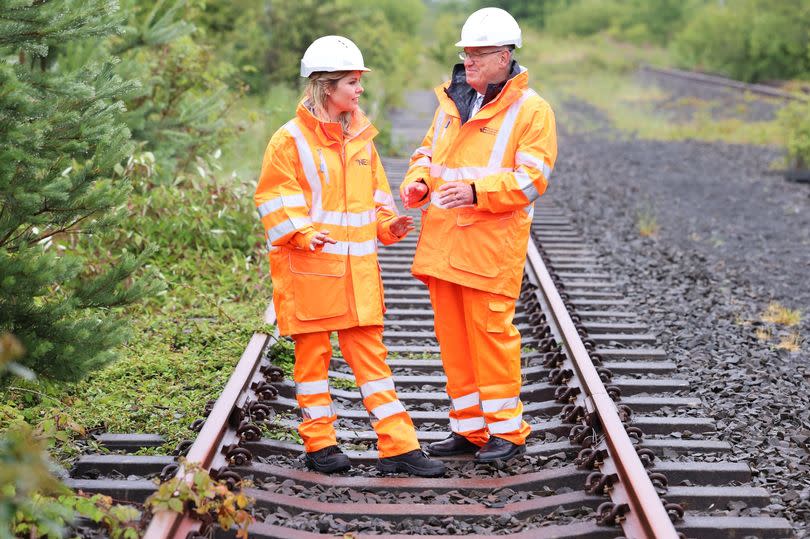Mayor vows to bring Tyne and Wear Metro to Washington with £8m boost for Leamside Line restoration
North East mayor Kim McGuinness will pump more than £8 million into efforts to finally bring the Tyne and Wear Metro to Washington.
Huge plans to expand the Metro network could see it extend from its current endpoint in South Hylton through to Washington, the fourth biggest town in the UK without a railway station, then onto Follingsby and rejoin at Pelaw. The massive project would use the northern section of the mothballed Leamside Line, the restoration of which has been hailed as the single most important infrastructure upgrade needed across the North East.
While the opening of a ‘Washington Metro Loop’ is still years away and is expected to cost an estimated £745 million, the proposals are now set to take a key step forward. Ms McGuinness announced on Wednesday that she plans to invest £8.6 million of her mayoral funds into developing the business case for the scheme, the largest cash injection to date for the long-debated Leamside Line project.
Though meeting the vast cost of the restoration will be beyond the scope of the mayor’s budget, she told the Local Democracy Reporting Service (LDRS) that she was confident of turning the plans into reality. Speaking on a visit to a section of the Leamside Line in Follingsby, Ms McGuinness said: “It is a long-term project because it takes time to get trains running on tracks like this. But this shows a commitment.
"We said we would deliver it and I would not be standing here committing money to a business case if I did not think we would be getting Metros running all the way to Washington. It is so important to the people of the region that we sort out our public transport.
"This is about getting people out of their cars, getting them to new jobs, building good quality housing along this route, and unlocking real opportunity in our region – this is the infrastructure we need to do that. We have been talking about it for a really long time and now we are getting on with it.”
Returning trains to the Leamside Line has been top of North East leaders’ wishlist for years. The route, which runs all the way from Pelaw in Gateshead to Tursdale in County Durham, could allow not only for the extension of the Metro and the creation of other new rail connections across the region, but also free up space on the congested East Coast Main Line by offering an alternative route for freight trains.

It is estimated that the Washington Metro Loop alone would generate at least £90 million per year in economic benefits for the region, reduce car journeys by 1.7 million a year and cut carbon emissions by 87,000 tonnes annually. But the Leamside Line became the subject of a political storm last year when it was dropped from a list of pledges made under Rishi Sunak’s Network North transport programme, less than 24 hours after it was announced.
The Labour Party has also refused to commit to delivering the Leamside Line, the full restoration of which would cost well over £1 billion, saying earlier this year that it would not “treat the people of the North East like fools” by making a promise it does not know it could keep.
Ms McGuinness, elected for Labour as the first mayor of the North East in May, told the LDRS that she “will be having conversations about how we bring together the money”, including asking the new Labour government for funding, but warned that regional transport officials will have to “think differently” and look at partnerships with private businesses too.
Gateshead Council leader Martin Gannon, the deputy mayor, added that the Leamside Line would “radically transform the economic prospects of quality of life of people in the North East of England”. He claimed that “rather than a project that was decades out, we are now within touching distance” and insisted he was “very confident” of finding the cash to deliver it.
Coun Gannon, who leads on transport issues in the North East Combined Authority’s (NECA) cabinet, added: “The secret to unlocking funding is to have a compelling business case…. We anticipate that the full cost for all the stations and to get it open will be around £740 million. That is a lot of money, three quarters of a billion.
"We have just come through an election campaign where people are saying there is no money and we are going to make a case to the government for £0.75 billion. But the economic assessment shows that by making that investment it shows an increased income to North East England of £90 million a year. I think that is a compelling case.”
A report is due to go to the NECA cabinet later this month to formally approve the £8.6 million investment. £8 million of that will be used to develop an outline business case for the Washington Metro Loop by 2026 – including full information on the route’s proposed stations and estimated costs.
A further £600,000 will be used to commission a strategic outline case for Leamside South, the southern section of the line connecting Washington and Sunderland to the East Coast Main Line. There is also a final section of the Leamside vision that would take trains through to Ferryhill and to Teesside beyond that.
Cathy Massarella, managing director of Metro operator Nexus, said: “The Washington Metro Loop will be truly transformative, enhancing access to employment opportunities, education, healthcare and leisure activities for the people of Washington. This funding will enable Nexus to develop a detailed business case and marks a really positive step forward in the project.”

 Yahoo News
Yahoo News 
